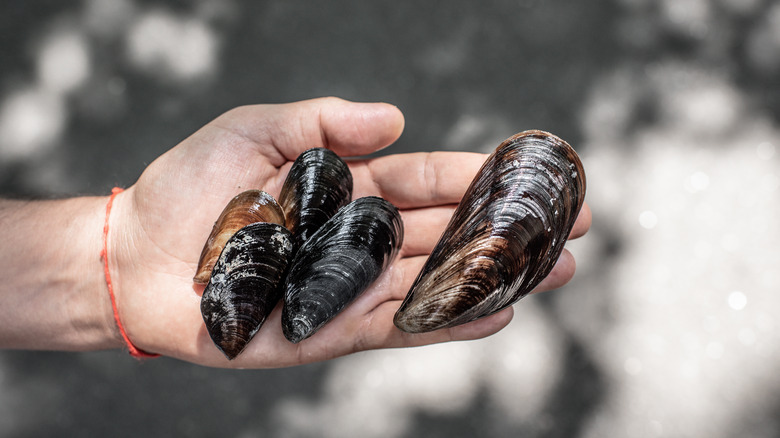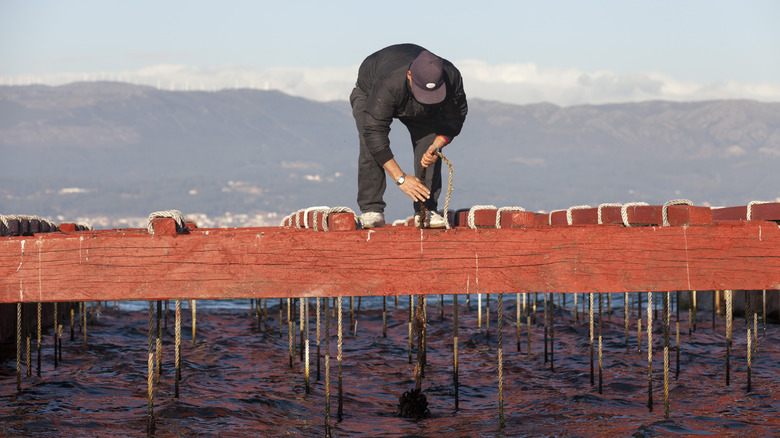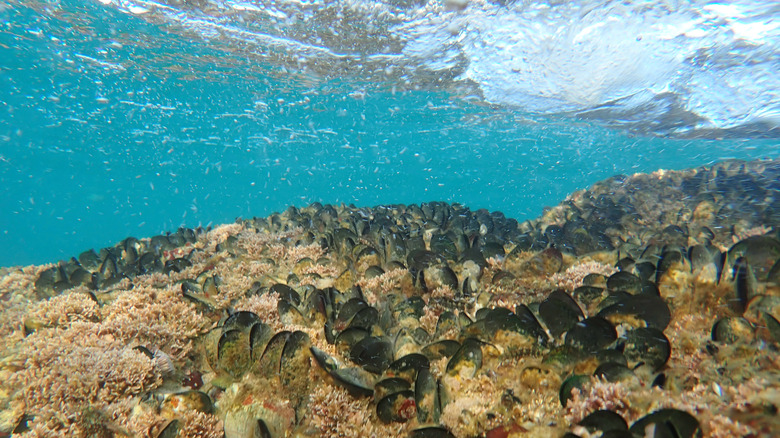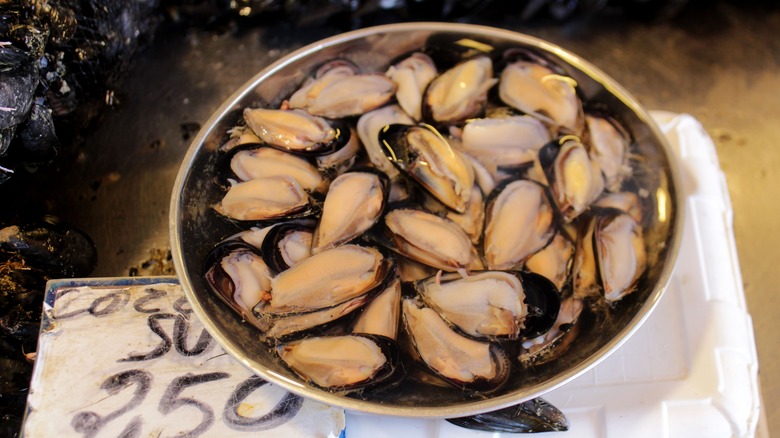The Real Difference Between Farmed And Wild Mussels
Whether you like 'em with garlic cream sauce, steamed with fries, or even slathered with coconut and curry, there's a good chance mussels are coming to your table as part of that seafood tower. In 2016, the US produced nearly 900,000 pounds of mussels, a total value of over $10 million, via FishWatch. Considering the US isn't even among the top-ranking countries for mussel farming (China, Chile, and Spain are the top mussel producers in the world, per ASC Aqua), the seafood market is just lousy with mussels. Folks can't get enough.
According to seafood safety organization the International Shellfish Sanitation Conference, mussels belong to the mollusk family, and their fragile fleshy bodies are protected from the elements by their two hinged shells. Since mussels are naturally herbivores, these shells also filter the microbacteria it eats as it floats through surrounding waters.
But, this is pretty much where the shared traits stop. The main distinction between types of mussels is whether they are farmed or wild — and it can have a bigger effect than you might think. So, what's the difference?
Home on the range
According to Pangea Shellfish, roughly 90% of the current global mussel supply is farmed — but, is farmed technically the right word for it? There has been some discrepancies amongst aquaculturalists as to whether "fishery" or "farming" is a better-fitting label for cultivating mussels. But, to clear up any confusion, the Food and Agriculture Organization of the United Nations (FAO) released a definitive description of aquaculture once and for all. In 1988, the FAO defined aquaculture as "the farming of aquatic organisms, including fish, molluscs, crustaceans and aquatic plants. Farming implies some form of intervention in the rearing process to enhance production, such as regular stocking, feeding, protection from predators, etc. Farming also implies individual or corporate ownership of the stock being cultivated." It considers aquaculture to be the equivalent of farming livestock on land
For example, Prince Edward Island mussels (named after the Canadian spot where they're grown) are smooth with a dark blue semi-round shell, describes PEI Mussel. Gary Wikfors, Ph.D., chief of the aquaculture sustainability branch at the National Oceanic and Atmospheric Administration (NOAA), explains that aquaculture farming is necessary to keep up with public demand. "The success of Prince Edward Island mussel farming has created a new market for mussels in the northeast United States that is growing beyond the production capacity of PEI," Wikfors explains. Nature can't churn out mussels as quickly as people are asking for them.
Get wild
Wild mussels are hearty little organisms. Blue mussels, a species of wild mussel, are highly resilient to environmental conditions due to their wide distribution across diverse waters from the northwestern to the southern coasts of the entire continent of Europe, per The Fish Site. Blue mussels can comfortably withstand prolonged periods of freezing temperatures, and their sturdiness, it says, helps them grow to be larger in size than their farmed counterparts.
A distinct feature of wild mussels is that they have a biological appendage called a "beard." According to New Zealand encyclopedia Te Ara, the beard (aka byssus) is a bundle of stretchy, organic threads produced by a gland in the mussel's foot. These threads allow the smooth, limbless, round mussel to adhere to various surfaces — an important ability in the wild.
However, despite their sturdiness, wild mussels are still vulnerable to predator attacks. Crabs and starfish can ravage a colony of mussels, via Global Seafood Alliance. Humans also pose a larger predatory threat to wild mussel habitats than farmed ones, it says. Wild mussels are usually harvested by being dredged directly from the seafloor, which directly impacts both the mussels and their environment.
What's the difference?
The main difference between farmed and wild mussels comes down to where and how they're grown.
Robert DiGregorgio, head of quality control at Fulton Fish Market, says that mussels begin spawning when springtime rolls around and water temperatures reach 55-60 degrees Fahrenheit. (In fact, Galloway Wild Foods recommends consumers avoid eating mussels from May to August, because the mussels' meat is lower quality from the exhaustion of spawning.) In typical mussel development, per PEI Mussel, baby mussel larvae begin forming their hard shell around the time they reach one inch in size. After their shell develops, they're called "spat." From there, though, whether a mussel is wild-versus-farmed changes the course of its development substantially.
Wild mussels grow in the sand on the bottom of the seafloor, according to American Mussel Harvesters, which evolutionarily makes them have harder shells and a higher meat-to-shell ratio. Wild mussels also have a more robust, seafood-y flavor and are prone to retaining some grit from growing in the sand. After the wild mussels are harvested, their beards are cut and they're washed in a bath of cool, sterilized, running water to remove the grit and bacteria.
By contrast, farmed mussels are held in suspended mesh socks that dangle underwater, via PEI Mussel. The suspension socks are tied to an anchor or buoy, and their fully exposed surface area allows water to fully aerate and clean the mussels as they grow.



